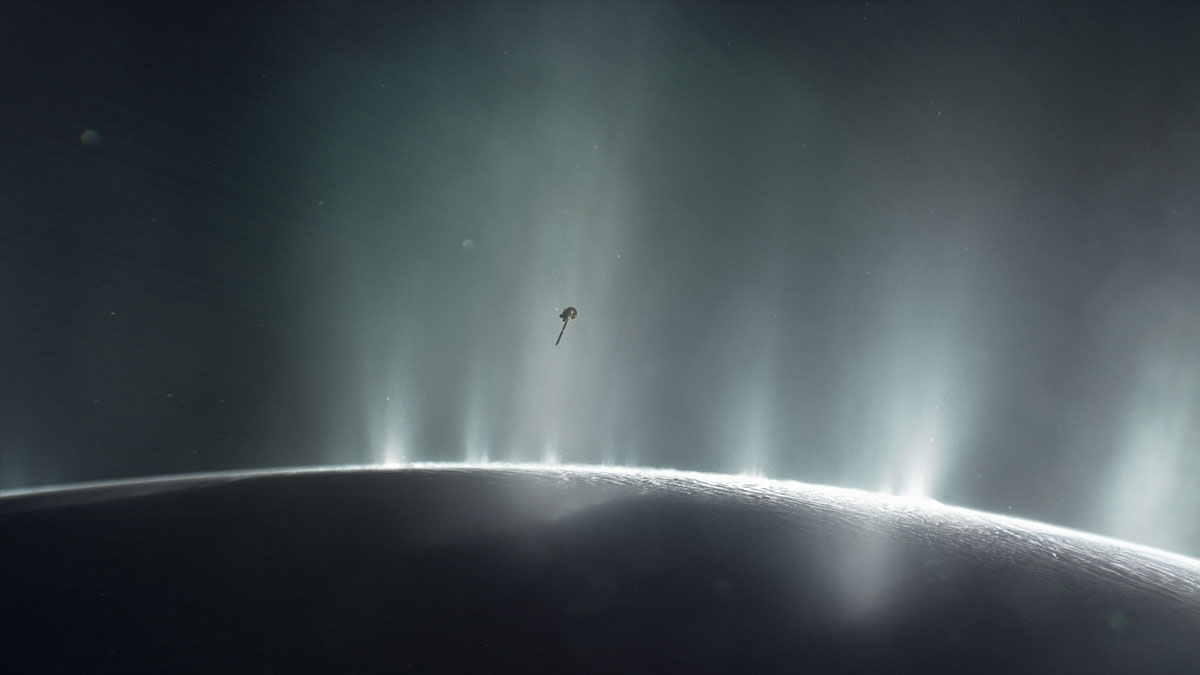When the Cassini spacecraft first flew above the south pole of Enceladus, a moon of Saturn, it did something no solar system explorer had done before: It took a shower. The craft zipped through plumes of water vapor and ice grains spewing from cracks in the icy moon’s surface. Cassini didn’t need to towel itself dry because the spray was thin. Combined with the craft’s earlier images, however, it provided strong evidence that a global ocean lies beneath the moon’s crust. Later analysis found hydrogen, carbon dioxide, methane, and tiny particles of rock in the plumes, suggesting the ocean could contain all the major ingredients for life.
The Cassini discoveries added Enceladus to a growing list of possible ocean worlds in our own solar system—bodies with large amounts of liquid water hidden from view. Some of them could contain more water than all of Earth’s oceans combined. And in addition to Enceladus, planetary scientists have counted at least one other member of the list, Jupiter’s moon Europa, among the ranks of the “possibly habitable.”
“There could be life in our own solar system, and we may already have flown past it.”
“There could be life in our own solar system, and we may already have flown past it,” said Christopher German, a senior scientist at Woods Hole Oceanographic Institution and a coleader of Network for Ocean Worlds (NOW), a NASA-funded effort to advance research on these intriguing bodies. “Instead of just a sci-fi thing, suddenly we have grounds for wondering if there’s life on these nearby worlds—places we have the technology to reach.”
“There are a lot of exciting places out in the universe, but for me, the most exciting are nearby,” said Tracy Becker, a group leader in planetary sciences at the Southwest Research Institute (SwRI) in San Antonio. “We can learn a lot about life in our own solar system, then extrapolate from that to learn about life elsewhere in the universe.”
As one key step in exploration, NASA wants to increase collaboration between planetary and Earth scientists, combining knowledge of the solar system with the experience of exploring Earth’s oceans and extreme habitats.
“Planetary and Earth scientists are in different orbitals,” said Alison Murray, a research professor at the Desert Research Institute in Reno, Nev., and a NOW coleader. “We’re trying to bring scientists together to begin conversations, to identify areas of common interest.”
One early effort is Ocean Sciences Across the Solar System, which German described as a “public outreach effort for scientists.” It has included workshops and other steps that resulted in a white paper and a set of articles for a special issue of Oceanography.
“The coordinated efforts of scientists that work in both Earth’s ocean and oceans in other parts of the Solar System will allow knowledge gaps to be filled and opportunities to be identified for testable ideas based upon existing knowledge of the Earth’s system,” according to the white paper. “The two communities began as one, and this initiative will bring the two communities back together for a unified focus.”
“We have a lot to learn from each other,” said Amanda Hendrix, a senior scientist at the Planetary Science Institute in Tucson, Ariz., and coleader of a NASA committee that produced a 2019 report on exploring ocean worlds. “People have been studying Earth’s oceans for many decades, so they have a head start. That [experience] can be leveraged by planetary scientists to help us understand and put into perspective the oceans in the outer solar system.”
Expanding the Goldilocks Zone
And there’s plenty for scientists to explore.
German said scientists have identified five “confirmed” ocean worlds beyond Earth: Jupiter’s moons Callisto, Europa, and Ganymede and Saturn’s moons Enceladus and Titan. That list could be just the tip of the planetary iceberg, however. “There are probably 20 candidates from places that haven’t been studied closely since the Voyager missions of the 1980s,” German said.
“Europa might have more water than all of Earth’s oceans, which is mind-boggling—we hit the celestial jackpot. It opens up endless possibilities.”
Some of those worlds appear to contain the major ingredients for life: water, an energy source, and the right chemistry.
“Fifty years ago, we confidently thought there was only one habitable world in our solar system,” said German. “Now we’re not so sure that’s a safe assumption.”
“These moons have flipped the whole paradigm of the ‘Goldilocks zone,’” the distance from a star where conditions are considered most comfortable for life, said Ved Chirayath, a professor of Earth sciences at the University of Miami and a former director of the Laboratory for Advanced Sensing at NASA’s Ames Research Center in California. “They’re really far from the host star, so they should be rigid, frozen bodies. But Europa might have more water than all of Earth’s oceans, which is mind-boggling—we hit the celestial jackpot. It opens up endless possibilities. You don’t have to be in the Goldilocks zone to be considered a home for life.”
Enceladus and Europa are the highest-priority targets for study. Their oceans are the most accessible of all the watery worlds and are thought to be the most comfortable for life.
Europa’s ocean was discovered first. When Voyager 1 and 2 flew through the Jovian system in the late 1970s, their photographs of Europa revealed icy terrain similar to that found in the Arctic and other frozen regions on Earth. The almost pure ice is extremely smooth, with few impact craters, indicating the surface is young. Large blocks of ice are jumbled at odd angles, suggesting they’re floating atop a layer of liquid.
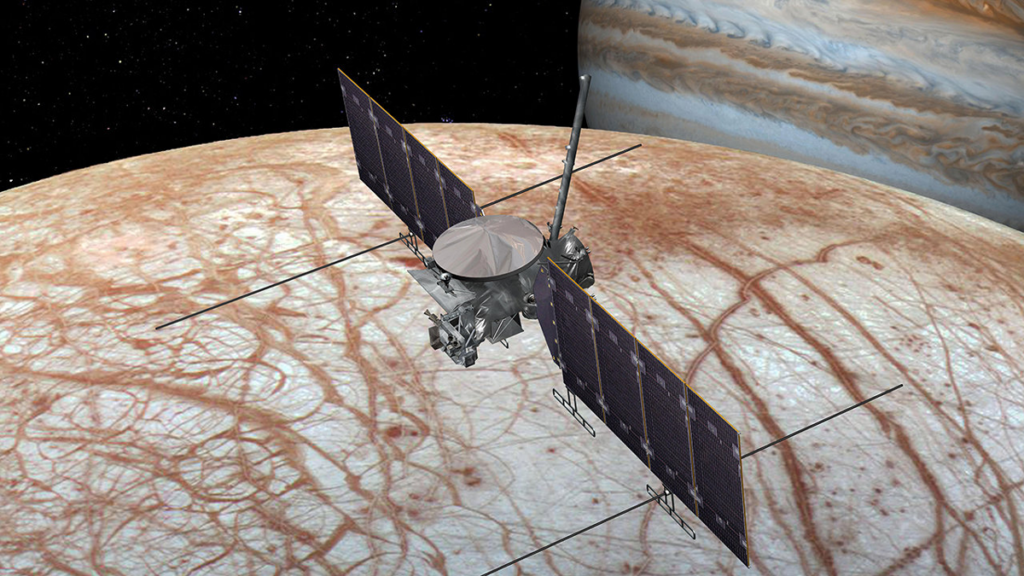
In addition, long, dark grooves that crisscross the icy crust may mark the edges of large ice sheets—the equivalent of tectonic plates on Earth. “Europa seems to have its own form of plate tectonics,” said Robert Pappalardo, project scientist for the Europa Clipper mission at the Jet Propulsion Laboratory (JPL) in California. “There seem to be places where the icy lithosphere has disappeared into the interior. There are rift zones and spreading regions that may be analogous to mid-ocean ridge spreading. As a geologist, that gets me really excited.”
What sealed the deal on identifying Europa as an ocean world, however, were observations by the magnetometer on the Galileo spacecraft, which looped through the Jupiter system from 1995 to 2003. “Subsurface oceans reveal themselves magnetically through a process called electromagnetic induction,” said Corey Cochrane, leader of the Europa Clipper magnetometer at JPL. Interactions with Jupiter’s magnetic field create electric currents within Europa, spawning secondary magnetic fields.
“Nobody expects to see aliens walking around, but just the fact that life could form in a simple microbial state is really important.”
“I’d give it a 90-ish-percent chance of being a salty ocean,” said Pappalardo. “The magnetic data [imply] that there has to be a salty ocean. The readings are hard to explain otherwise.”
The heat to keep the ocean from freezing comes from a tug-of-war between Jupiter and some of its large moons. That tug-of-war twists and tugs Europa’s interior, generating heat. Models suggest there could be hydrothermal vents on Europa’s seafloor, belching hot, mineral-rich water into the ocean. On Earth, such vents typically support vigorous ecosystems sustained by microbes that obtain their energy from molecules in the water. “Everything we know about Europa makes it seem habitable,” said Murray, who was a member of a science definition team for a possible Europa lander.
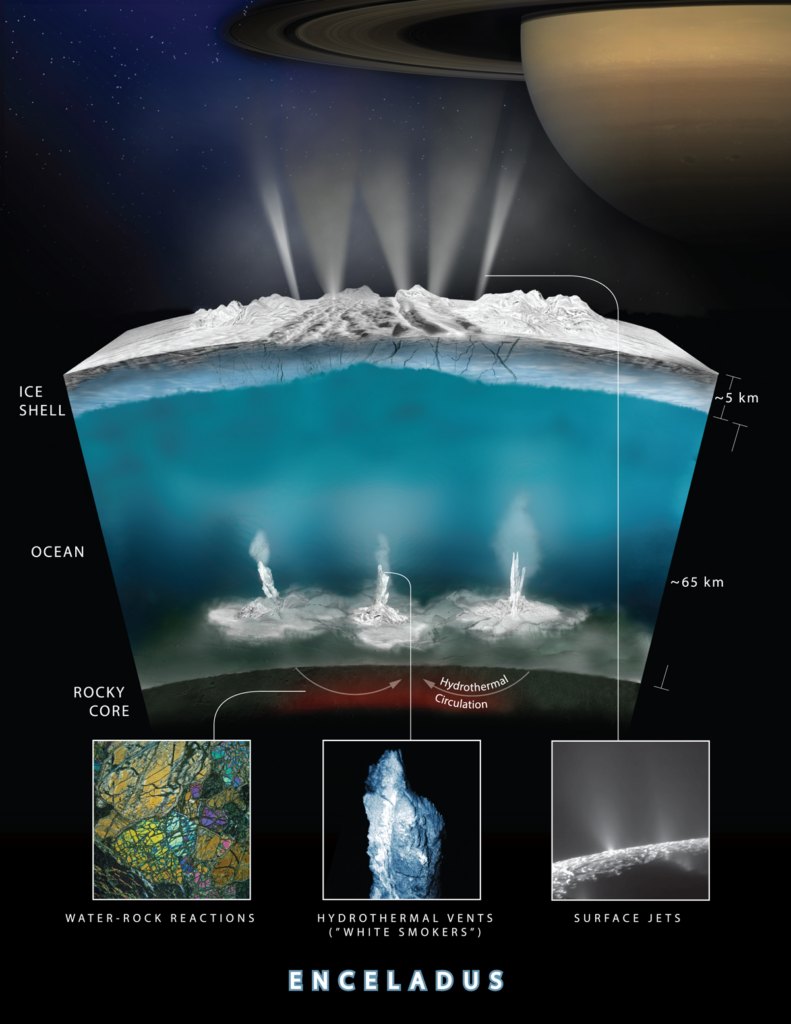
“I’m [cautiously optimistic] that we’ll find life,” said Hendrix. “Nobody expects to see aliens walking around, but just the fact that life could form in a simple microbial state is really important. It helps us understand the potential beginnings of life on Earth and what is required to sustain life.”
Europa Clipper will help confirm the moon’s ocean and habitability for life. It is scheduled to launch in October 2024 and settle into orbit around Jupiter in 2030. It will sail past Europa more than 50 times, at distances of as close as 25 kilometers.
At that range, Clipper’s magnetometer will provide a far more detailed profile of the ocean. Its radar will measure the thickness of the ice cover and the depth of the ocean. Its imaging systems will map the ice at high resolution, perhaps revealing spots where water is flowing to the surface. And it will measure how much the crust is flexing in response to tides; models predict a 30-meter daily flexure if there’s a subsurface ocean but only about 1 meter if there’s nothing but solid ice, Pappalardo said.
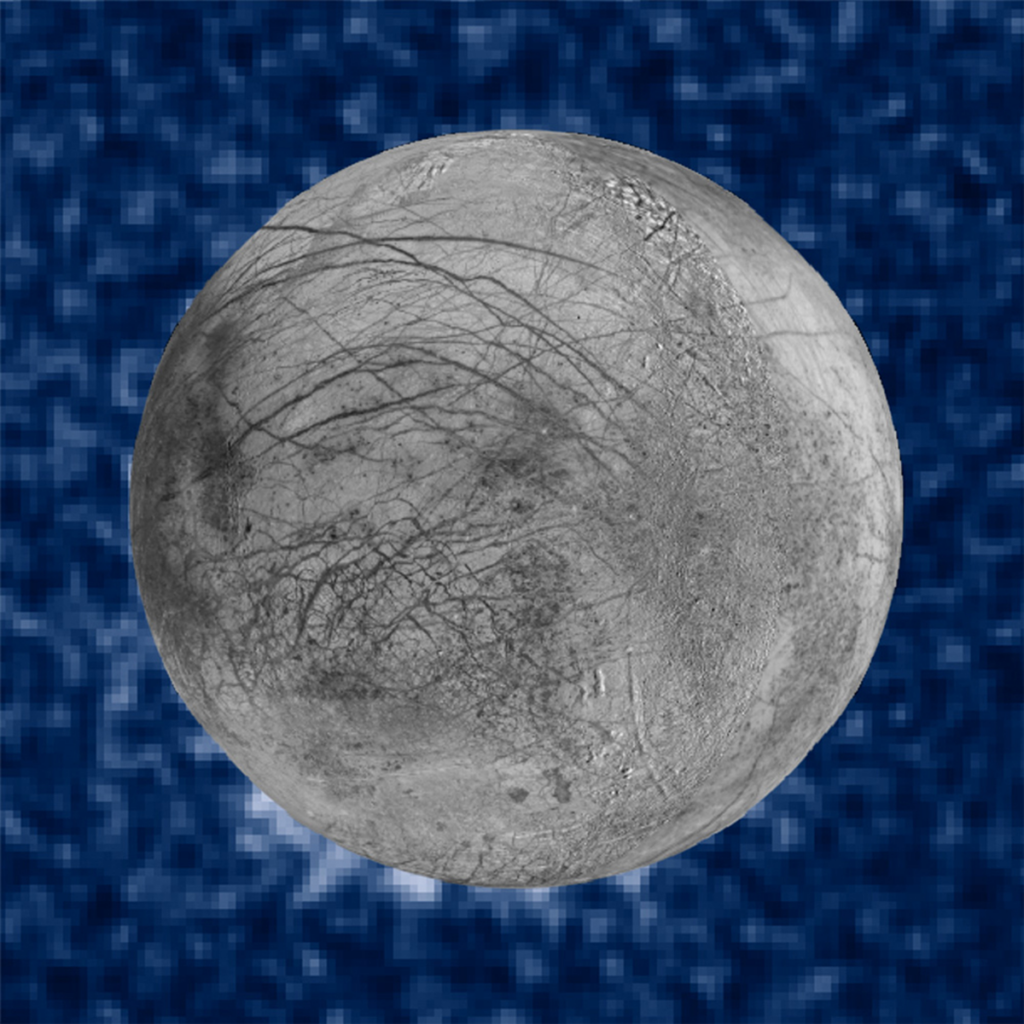
Other instruments will search for particles in possible plumes erupting from below the surface. A 2012 observation by the Hubble Space Telescope showed a possible plume of water and ice squirting up to 200 kilometers high. “If we find them, we have the potential to fly through the plumes with the dust collector and mass spectrometer and get down to the heart of what’s in that ocean,” said Becker.
Keeping Contact Between Water and Rock
Hopping through a cold shower like the ones they hope to find on Europa is how scientists discovered the ocean on Enceladus, of course, and future missions with better detectors could provide a far more detailed profile.
“Enceladus is the easy, low-hanging fruit,” said Chirayath. “If you get to orbit, you have the ocean brought to you. It could contain bacteria, which you can sample from your comfy orbital home. As for detecting that life, I’m very much of the camp that you’ll know it when you see it. It shouldn’t be that hard to detect.”
The ocean could be 40 kilometers deep, with some spots 20 kilometers deeper, below an ice crust that averages about 20 kilometers thick. As at Europa, the ocean is thought to be in contact with the rocky core, which is a key to habitability: The core offers the possibility of hydrothermal vents to supply the energy and chemistry for life.
A recent study suggested that the vents could supply phosphorus, a critical ingredient for life on Earth. “Phosphorus has two critical roles,” said Christopher Glein, a lead scientist at SwRI and one of the authors of the study. “One is with genetic molecules—it joins the building blocks of DNA and RNA—and one is with energy-bearing molecules—it allows cells to transfer energy through different reactions. As far as we know, phosphorus is essential for life.” Glein and colleagues are perusing the Cassini observations to see whether the craft sniffed phosphorus in the plumes.
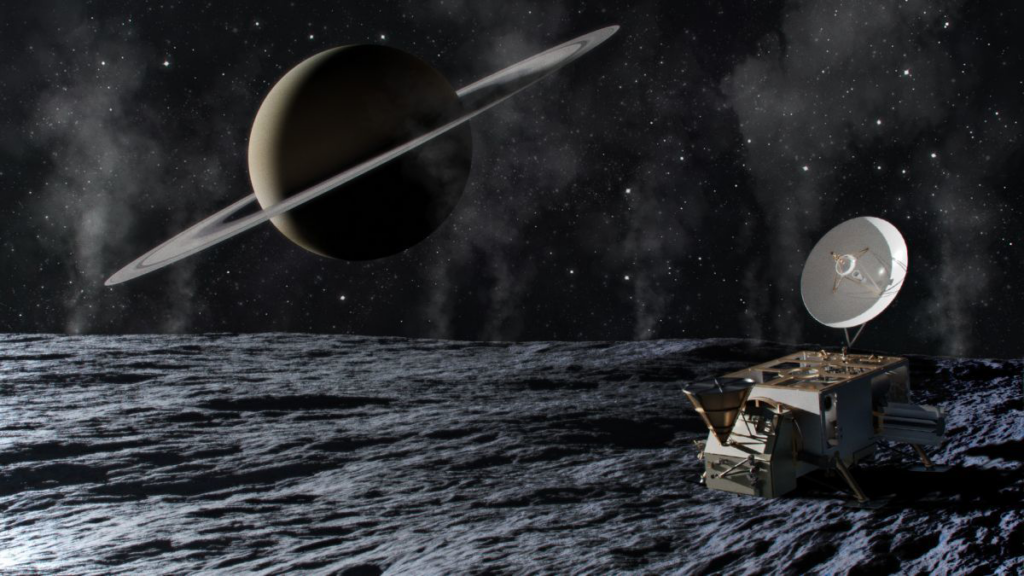
The 2023–2032 decadal survey for planetary science and astrobiology, an advisory report from the National Academies of Sciences, Engineering, and Medicine that outlined exploration goals for NASA, recommended a flagship mission to Enceladus. Known as Orbilander, it would orbit the moon for about a year, sampling the plumes and mapping possible landing sites. It then would land and sample freshly fallen plume material around “tiger stripes”—the dark cracks from which the plumes emanate.
“The plumes are really, really thin, so we’re limited because there’s not a lot of stuff in them,” Glein said. “But if you can go to the surface and get a big scoopful, now you’re in business.”
Another high-priority target is a “double” ocean world, with liquids on, as well as beneath, the surface. Lakes and seas of liquid methane, ethane, and nitrogen dot Titan, the largest moon of Saturn and the only solid body in the solar system other than Earth with liquids on its surface. In addition, scientists suspect Titan has a buried ocean of liquid water mixed with ammonia and other compounds that could be the most massive ocean in the solar system.
Titan’s cold, dense atmosphere consists mainly of nitrogen, with a smattering of methane and smaller amounts of other organic compounds that envelop the moon in an orange “smog.” Methane and ethane form clouds, producing rains that carve river channels and fill the lakes and seas.
“Its hydrocarbon seas could be just as hospitable for life as liquid water oceans,” said Chirayath, although he noted that Titanian life might not resemble Earth life at all. The deep ocean could provide marginally habitable conditions for Earth-like microbes, and ice volcanoes could carry some of the moon’s water to the surface, where future missions might sample it.
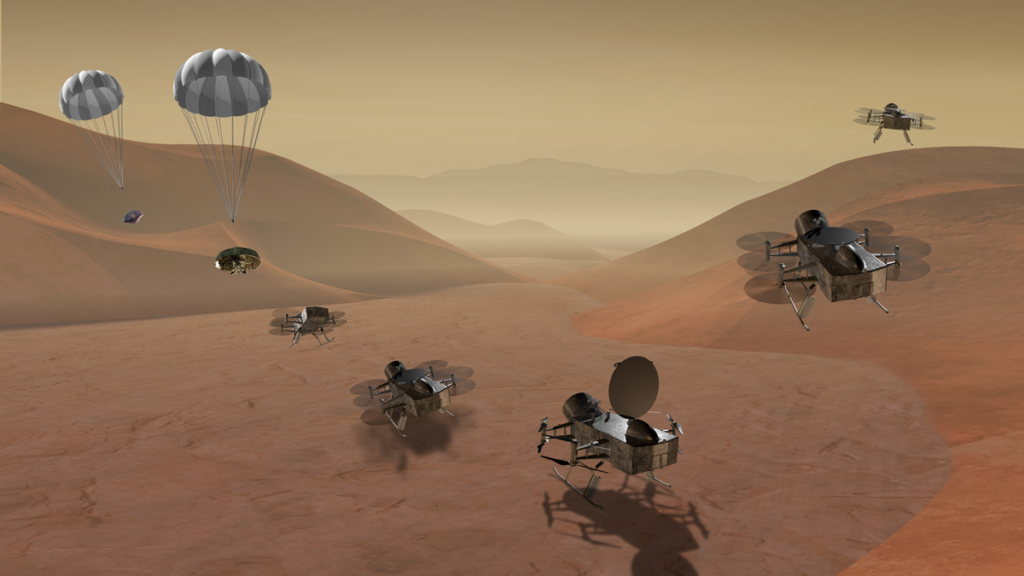
NASA already has one Titan explorer on the books. Dragonfly is a quadcopter—a box with rotors at each corner—that’s being developed as a New Frontiers mission (the same program as New Horizons, which flew past Pluto). Scheduled for launch in 2027 and arrival in 2034, Dragonfly will photograph the landscape from altitudes of up to 4 kilometers, measure weather conditions, and collect samples for analysis by a mass spectrometer.
Sandwiches and JUICE at Jupiter
Many of the solar system’s other putative ocean worlds will be much harder to penetrate, either because of their distance or because their oceans are less accessible.
The latter is the case for Jupiter’s largest moons, Ganymede and Callisto. Evidence has suggested they have extensive oceans, but they’re buried quite deep, and there’s no obvious way for water to percolate to the surface. “Their ice shells are probably a hundred or more kilometers thick because they don’t have as great a degree of tidal heating,” said Pappalardo.
In addition, the stronger gravity of both worlds probably helps create “sandwiches” of alternating layers of water and ice, with ice forming the bottom slice of bread. That means the liquid water isn’t in contact with rock, so the rocky layers can’t inject energy and life-supporting chemical compounds, reducing the moon’s habitability.
We should learn much more about both Ganymede and Callisto from the Jupiter Icy Moons Explorer (JUICE), a European mission scheduled to launch in April 2023 and arrive at Jupiter in 2031. It will fly past Ganymede, Callisto, and Europa several times before entering orbit around Ganymede in 2034. Among its goals is characterizing the oceans of the two biggest moons.
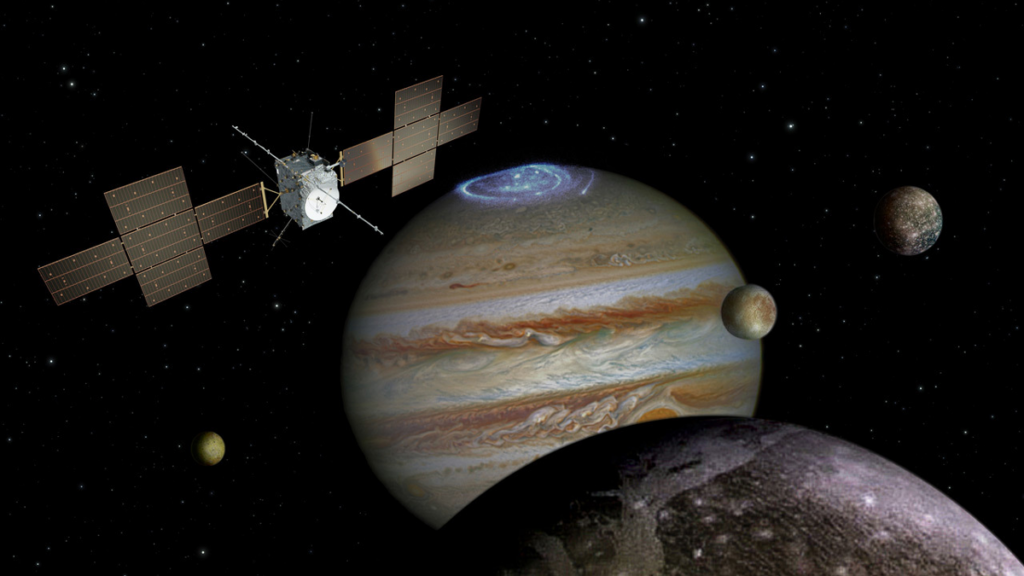
“We’re having conversations with the JUICE scientists on what kinds of synergies there are—how having both spacecraft at the same time can contribute to even better science,” said Pappalardo.
Some of the moons of the ice giants Uranus and Neptune are good ocean world candidates, but the planets are so remote that each has been visited only once, by Voyager 2, in 1986 and 1989, respectively. The decadal survey recommended visiting both systems again. A Uranus orbiter and probe were its highest-ranked new flagship mission for the next decade, with a mission to Neptune among the priorities for a New Frontiers mission.
One goal of the Uranus mission would be to reconnoiter the system’s moons, at least five of which are in the “possible” ocean world category (none of them has been confirmed, though).
“Despite the fact that they are part of a giant planet system, the moons have benefited from little tidal heating throughout their history,” said Julie Castillo-Rogez, a planetary scientist at JPL who has a paper about the moons scheduled for publication. “One of the key parameters driving tidal heating is the mass of the planet—the bigger the planet, the bigger the tidal deformation and the resulting tidal dissipation. As Uranus’s mass is 7 times smaller than Saturn’s mass, tidal dissipation in the moons of Uranus is about 50 times less than dissipation in the moons of Saturn.”
“Triton is a ‘maybe’—it’s not a confirmed ocean world. But Voyager found tantalizing clues of a subsurface ocean.”
That means that the smaller of the five candidates, Miranda, Ariel, and Umbriel, are more likely to be frozen through. But Castillo-Rogez said the two largest moons, Titania and Oberon, should be better able to retain their internal heat. In addition, motions within the mantles of both worlds should pump hot water into the icy layers above. “So there is a high likelihood that these moons would hold deep oceans at present,” she said.
Instruments on the Uranus mission would look for evidence of oceans and locations where they might interact with the surface, plot magnetic fields generated by the oceans, and measure the chemistry of the surface and any possible plumes.
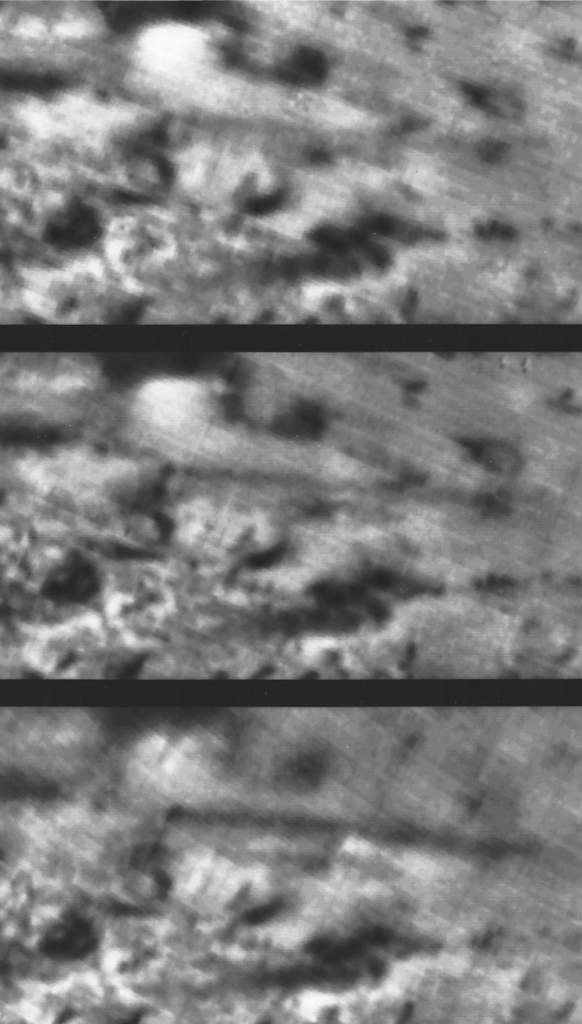
Plumes are among the many intriguing features of Triton, the largest moon of Neptune, which is a high priority for a possible New Frontiers mission.
“Triton is a ‘maybe’—it’s not a confirmed ocean world,” said Hendrix. “But Voyager found tantalizing clues of a subsurface ocean.”
Voyager 2’s pictures revealed one of the oddest and most intriguing surfaces in the solar system. It consists of frozen nitrogen, water, and carbon dioxide, and it displays terrains found nowhere else in the solar system. Geysers of frozen nitrogen and other ices, mixed with dark organic compounds, shoot up to 8 kilometers high and deposit surface streaks many kilometers long.
Triton probably has enough internal heat to sustain a habitable subsurface ocean. The organic compounds in the geysers heighten the interest in studying the big moon, which may be a captured dwarf planet.
Dwarf Planets and Beyond
The dwarf planets Pluto and Ceres also are on the list of possible ocean worlds.
When New Horizons flew past Pluto in 2015, its images revealed a surprisingly active surface. They also revealed cracks and ridges that suggested Pluto began with an ocean of liquid water in contact with the rocky core. The ocean could have been 150 kilometers deep, and although it has partially frozen, it could still exist today. If so, Pluto could have remained habitable for almost the entire history of the solar system.
Verifying that scenario probably requires a follow-up mission. Thanks to Pluto’s great distance, however, that mission is not likely to happen for decades. But a much closer dwarf planet, Ceres, is a more inviting target. In fact, the decadal survey recommended a sample return mission as a possible New Frontiers priority.
Ceres is the largest member of the asteroid belt, and we obtained a thorough reconnaissance from NASA’s Dawn mission, which entered orbit in 2015 and operated until late 2018.
The mission created a sensation as it approached Ceres because its early images showed a brilliant white spot on the otherwise dark disk. As Dawn settled into orbit, it found that the spot and several smaller ones were deposits of salts that probably bubbled to the surface from an ocean.
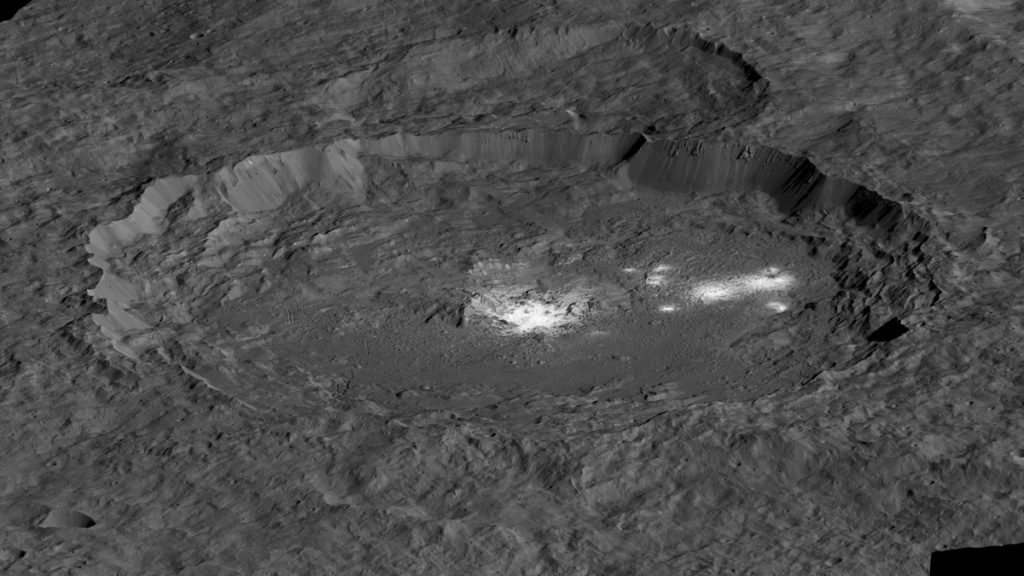
Ceres is about 25% water. Most of it probably is frozen, although some could still form a subsurface ocean or individual seas.
“Dawn found organics on the surface and active geology—brine-driven activity on the surface,” said Hendrix. “That makes it an extremely interesting target. It’s not clear what type of ocean it might have, or even if it currently has one. It’s definitely not an ocean world like Europa or Enceladus. But I think of ocean worlds as a spectrum. Each one is different, and each one tells us about how oceans form, how they’re sustained, how they become habitable, how they remain habitable, and whether they really can sustain life. In my ideal world, we’d have missions to all of them.”
Not surprisingly, that’s a common sentiment among both planetary and marine scientists. Characterizing the oceans of other worlds can tell us much more about how Earth’s oceans formed and evolved, reveal details about the formation and evolution of the Sun’s entire planetary system, and guide studies of exoplanets and their moons. “Ocean worlds may be the most common habitats in the universe, not for complex life but for simple life,” said Pappalardo.
Even finding no life on the solar system’s ocean worlds would be an important discovery, scientists said.
“One of the real pivotal reasons to explore these worlds is to get clues to where we came from,” said Glein. “If we find life and it’s similar to life on Earth, it might make a linkage between hydrothermal systems and the origins of life. But if we find that someplace like Enceladus is a great place to live, with all sorts of nutrients and energy sources and other critical requirements, but there’s nothing there but a sterile ocean, then that would be profound…. From an emotional standpoint it would be disappointing, for sure. But scientifically, we’d gain a whole new piece of knowledge. So let’s go have a look.”
“Ocean worlds in the solar system turn out to be a lot more common than we thought even 20 years ago,” said Murray. “What will we know in another 20 years?”
—Damond Benningfield, Science Writer

